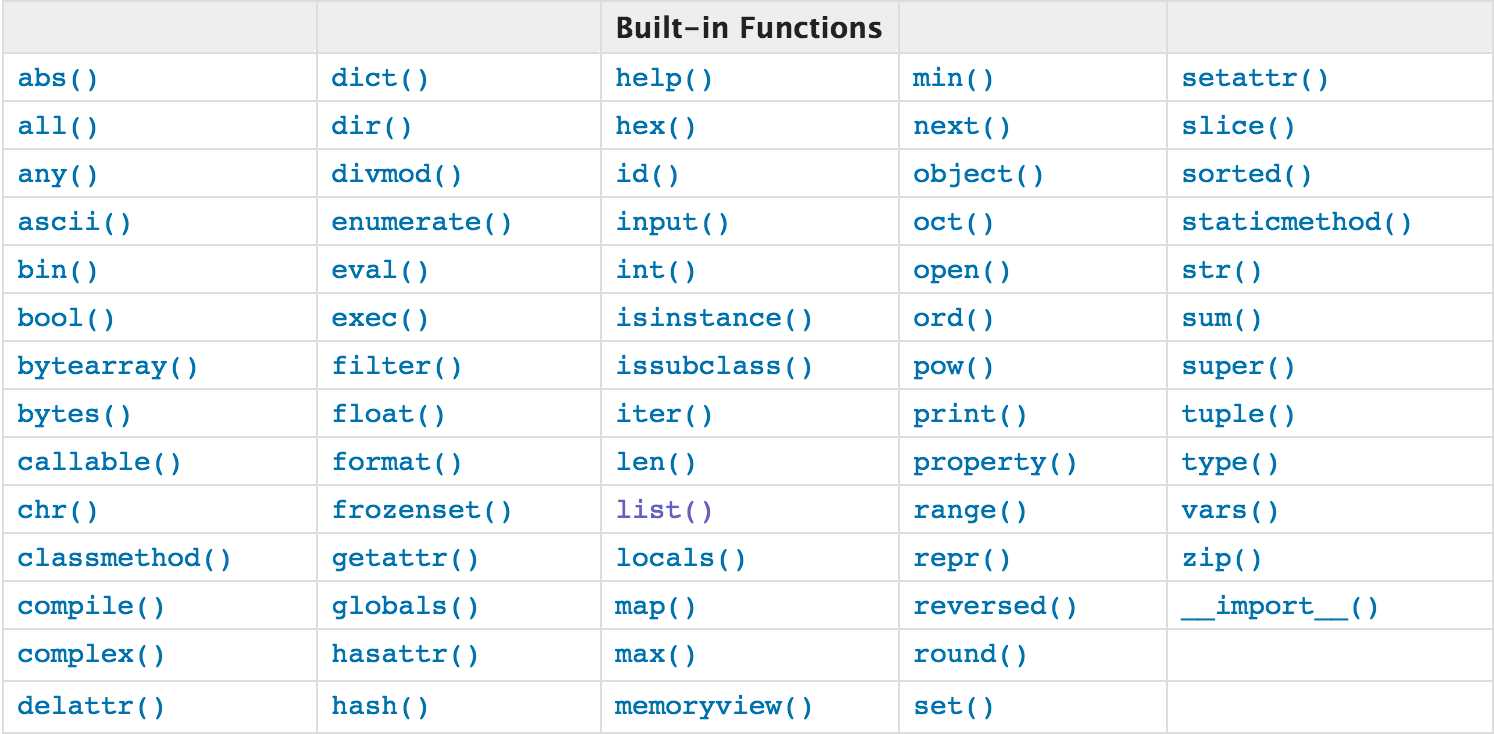三元运算
三元运算,是条件语句的简单的写法。如果条件为真,则返回值1,否则,返回值2。
ret = 值1 if 条件 else 值2
深浅拷贝
对于数字(int)和字符串(str)而言,赋值、深拷贝、浅拷贝都无意义,因为内存地址指向同一个。
import copy # ######### 数字、字符串 ######### n1 = 123 # n1 = "i am a student" print(id(n1)) # ## 赋值 ## n2 = n1 print(id(n2)) # ## 浅拷贝 ## n2 = copy.copy(n1) print(id(n2)) # ## 深拷贝 ## n3 = copy.deepcopy(n1) print(id(n3))
对于字典、元祖、列表 而言,进行赋值、浅拷贝和深拷贝时,其内存地址的变化是不同的。
(1)赋值,只是创建一个变量,该变量指向原来内存地址;
(2)浅拷贝,在内存中只额外创建第一层数据;
(3)深拷贝,在内存中将所有的数据重新创建一份(排除最后一层,即:python内部对字符串和数字的优化)。
函数
在学习函数之前,写代码一直是面向过程编程,即:代码执行顺序从上到下,一段代码执行所需的功能,频繁涉及到重复内容。
为了更好的代码重用性和可读性,出现了函数和面向对象。
- 函数式:将某功能代码封装到函数中,日后便无需重复编写,仅调用函数即可
- 面向对象:对函数进行分类和封装,让开发“更快更好更强...”
def 函数名(参数): ... 函数体 ... 返回值
函数的定义主要有如下要点:
- def:表示函数的关键字
- 函数名:函数的名称,日后根据函数名调用函数
- 函数体:函数中进行一系列的逻辑计算
- 参数:为函数体提供数据
- 返回值:当函数执行完毕后,可以给调用者返回数据。
内置函数

查看详细内容:点这里!
open函数,该函数用于文件处理
操作文件时,一般需要经历如下步骤:
- 打开文件
- 操作文件
一、打开文件:f = open("文件路径","打开模式")
打开文件的模式有:
- r ,只读模式【默认】
- w,只写模式【不可读;不存在则创建;存在则清空内容;】
- x, 只写模式【不可读;不存在则创建,存在则报错】
- a, 追加模式【可读; 不存在则创建;存在则只追加内容;】
"+" 表示可以同时读写某个文件
- r+, 读写【可读,可写】
- w+,写读【可读,可写】
- x+ ,写读【可读,可写】
- a+, 写读【可读,可写】
"b"表示以字节的方式操作
- rb 或 r+b
- wb 或 w+b
- xb 或 w+b
- ab 或 a+b
注:以b方式打开时,读取到的内容是字节类型,写入时也需要提供字节类型
二、操作

class TextIOWrapper(_TextIOBase): """ Character and line based layer over a BufferedIOBase object, buffer. encoding gives the name of the encoding that the stream will be decoded or encoded with. It defaults to locale.getpreferredencoding(False). errors determines the strictness of encoding and decoding (see help(codecs.Codec) or the documentation for codecs.register) and defaults to "strict". newline controls how line endings are handled. It can be None, ‘‘, ‘\\n‘, ‘\\r‘, and ‘\\r\\n‘. It works as follows: * On input, if newline is None, universal newlines mode is enabled. Lines in the input can end in ‘\\n‘, ‘\\r‘, or ‘\\r\\n‘, and these are translated into ‘\\n‘ before being returned to the caller. If it is ‘‘, universal newline mode is enabled, but line endings are returned to the caller untranslated. If it has any of the other legal values, input lines are only terminated by the given string, and the line ending is returned to the caller untranslated. * On output, if newline is None, any ‘\\n‘ characters written are translated to the system default line separator, os.linesep. If newline is ‘‘ or ‘\\n‘, no translation takes place. If newline is any of the other legal values, any ‘\\n‘ characters written are translated to the given string. If line_buffering is True, a call to flush is implied when a call to write contains a newline character. """ def close(self, *args, **kwargs): # real signature unknown 关闭文件 pass def fileno(self, *args, **kwargs): # real signature unknown 文件描述符 pass def flush(self, *args, **kwargs): # real signature unknown 刷新文件内部缓冲区 pass def isatty(self, *args, **kwargs): # real signature unknown 判断文件是否是同意tty设备 pass def read(self, *args, **kwargs): # real signature unknown 读取指定字节数据 pass def readable(self, *args, **kwargs): # real signature unknown 是否可读 pass def readline(self, *args, **kwargs): # real signature unknown 仅读取一行数据 pass def seek(self, *args, **kwargs): # real signature unknown 指定文件中指针位置 pass def seekable(self, *args, **kwargs): # real signature unknown 指针是否可操作 pass def tell(self, *args, **kwargs): # real signature unknown 获取指针位置 pass def truncate(self, *args, **kwargs): # real signature unknown 截断数据,仅保留指定之前数据 pass def writable(self, *args, **kwargs): # real signature unknown 是否可写 pass def write(self, *args, **kwargs): # real signature unknown 写内容 pass def __getstate__(self, *args, **kwargs): # real signature unknown pass def __init__(self, *args, **kwargs): # real signature unknown pass @staticmethod # known case of __new__ def __new__(*args, **kwargs): # real signature unknown """ Create and return a new object. See help(type) for accurate signature. """ pass def __next__(self, *args, **kwargs): # real signature unknown """ Implement next(self). """ pass def __repr__(self, *args, **kwargs): # real signature unknown """ Return repr(self). """ pass buffer = property(lambda self: object(), lambda self, v: None, lambda self: None) # default closed = property(lambda self: object(), lambda self, v: None, lambda self: None) # default encoding = property(lambda self: object(), lambda self, v: None, lambda self: None) # default errors = property(lambda self: object(), lambda self, v: None, lambda self: None) # default line_buffering = property(lambda self: object(), lambda self, v: None, lambda self: None) # default name = property(lambda self: object(), lambda self, v: None, lambda self: None) # default newlines = property(lambda self: object(), lambda self, v: None, lambda self: None) # default _CHUNK_SIZE = property(lambda self: object(), lambda self, v: None, lambda self: None) # default _finalizing = property(lambda self: object(), lambda self, v: None, lambda self: None) # default
三、管理上下文
为了避免打开文件后忘记关闭,可以通过管理上下文,即:
with open(‘log‘,‘r‘) as f: ...
如此方式,当with代码块执行完毕时,内部会自动关闭并释放文件资源。
在Python 2.7 及以后,with又支持同时对多个文件的上下文进行管理,即:
with open(‘log1‘) as obj1, open(‘log2‘) as obj2:
pass
lambda表达式
学习条件运算时,对于简单的 if else 语句,可以使用三元运算来表示。
对于简单的函数,也存在一种简便的表示方式,即:lambda表达式。
# 普通条件语句 if 1 == 1: name = ‘wupeiqi‘ else: name = ‘alex‘ # 三元运算 name = ‘wupeiqi‘ if 1 == 1 else ‘alex‘ # ###################### 普通函数 ###################### # 定义函数(普通方式) def func(arg): return arg + 1 # 执行函数 result = func(123) # ###################### lambda ###################### # 定义函数(lambda表达式) my_lambda = lambda arg : arg + 1 # 执行函数 result = my_lambda(123)
递归
利用函数编写如下数列:
斐波那契数列指的是这样一个数列 0, 1, 1, 2, 3, 5, 8, 13, 21, 34, 55, 89, 144, 233,377,610,987,1597,2584,4181,6765,10946,17711,28657,46368...
def func(arg1,arg2): if arg1 == 0: print arg1, arg2 arg3 = arg1 + arg2 print arg3 func(arg2, arg3) func(0,1)
